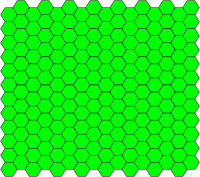Tiling by regular polygons

Imagine playing with different shapes, like squares and triangles. You can put them together to make bigger shapes, like rectangles or hexagons. When we put shapes together like this to cover a space, it's called tiling.
Now, let's focus on tiles that are regular polygons. That means the shape has equal angles and sides. Some examples are squares, triangles, and hexagons.
If we want to cover a floor or wall with regular polygon tiles, we have to think about how they will fit together. We don't want any gaps or overlaps, because that wouldn't look good or be practical.
To solve this problem, we can use a special rule called "tessellation." This means that we can fit the tiles together like puzzle pieces, without any gaps or overlaps.
For example, if we use squares, we can arrange them in a grid pattern. Every square fits perfectly against the ones next to it, with no extra space left over.
If we use triangles, we have to be a little more creative. We can arrange them in different patterns, like hexagons or diamonds. The key is to make sure that every triangle fits exactly against the ones next to it, without any empty spaces.
Tiling by regular polygons can be a fun and challenging puzzle. But once we figure out how to fit them together perfectly, we'll have a beautiful and functional design that can last for years to come.
Now, let's focus on tiles that are regular polygons. That means the shape has equal angles and sides. Some examples are squares, triangles, and hexagons.
If we want to cover a floor or wall with regular polygon tiles, we have to think about how they will fit together. We don't want any gaps or overlaps, because that wouldn't look good or be practical.
To solve this problem, we can use a special rule called "tessellation." This means that we can fit the tiles together like puzzle pieces, without any gaps or overlaps.
For example, if we use squares, we can arrange them in a grid pattern. Every square fits perfectly against the ones next to it, with no extra space left over.
If we use triangles, we have to be a little more creative. We can arrange them in different patterns, like hexagons or diamonds. The key is to make sure that every triangle fits exactly against the ones next to it, without any empty spaces.
Tiling by regular polygons can be a fun and challenging puzzle. But once we figure out how to fit them together perfectly, we'll have a beautiful and functional design that can last for years to come.
Related topics others have asked about:
